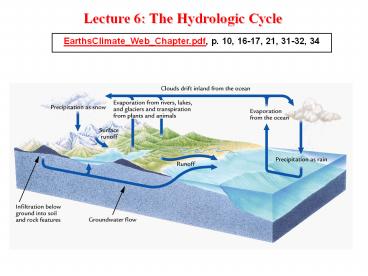Elements of the Sun; Solar Radiation - PowerPoint PPT Presentation
Title:
Elements of the Sun; Solar Radiation
Description:
Lecture 6: The Hydrologic Cycle EarthsClimate_Web_Chapter.pdf, p. 10, 16-17, 21, 31-32, 34 Geographic Distribution of Annual P-E (mm) Evaporation excess nearly ... – PowerPoint PPT presentation
Number of Views:106
Avg rating:3.0/5.0
Title: Elements of the Sun; Solar Radiation
1
Lecture 6 The Hydrologic Cycle
EarthsClimate_Web_Chapter.pdf, p. 10, 16-17, 21,
31-32, 34
2
Components of the Hydrologic Cycle
Evaporation, Condensation, Transport,
Precipitation, Transpiration, Runoff, Groundwater
Flow
http//ww2010.atmos.uiuc.edu/(Gh)/guides/mtr/hyd/s
mry.rxml
3
Water and the Planets
Earth the only planet where water can exist in
three forms. Water is essential to life.
4
Where Is Water On Earth?
Water is a vital component of the climate cycle.
5
Hydrologic Cycle
Movement of Water Between Stores
1. Most Rapid Movement In Vapor Phase, in the
Atmosphere 2. Most Water and Energy Storage In
Liquid Phase, in the Oceans 3. Most of Water
useful to Humanity in Rivers, Lakes,
Subterranean Water, and Ice and Snow, as Fresh
Water
6
Water Vapor
1. Highly variable spatially
- Near 0 over deserts
- 34 over tropical oceans/jungles
- Decreases rapidly with altitude most is within
a few km of the surface
- Decreases rapidly with latitude at the equator
is 10 times that at the poles
2. Importance to climate and climate change
Important part of the water cycle
ocean-to-land atmospheric vapor transport
balances land-to-ocean runoff.
The most important greenhouse gas water
vapor-temperature feedback.
Water vapor condenses to form clouds, thus
cloudsradiation feedback. Clouds release
rainfall, reflect solar radiation, and reduce the
infrared radiation emitted by Earth.
7
Cloud Development
Rising air expands, cools, and condenses to form
cloud
- Causes of a rising air mass
What causes the air to rise?
2. Widespread ascent due to convergence of
surface air
1. Surface heating and convection
Cold Front
Warm Front
4. Uplift along weather fronts
3. Orographic uplift
8
Steps in Making Precipitation
1. Water vapor in air
2. Air with vapor rises, expands, and cools
3. Vapor condensates around nuclei to form
droplets (clouds)
4. Droplets suspended by atmospheric upward
motion and turbulence
5. Droplets collide and coalesce into drops in
warm clouds and droplets diffuse to ice crystals
in cold clouds
6. Drops/crystals falls as rain/snow when they
are too heavy to be suspended by upward motion
9
Orographic Precipitation
Winds blowing moist air toward a mountain will
experience orographic uplift to an elevation
where dew point is reached and clouds are
formed. When the condensed moisture falls as
rainfall, the leeward side of the mountain is
kept in a rain shadow.
10
Topographic Controls on Precipitation
Westerly winds blowing moist air from the Pacific
Ocean encounter several mountain ranges that
create patterns of rising air and precipitation
followed by sinking air and warm dry rain shadows.
11
Global Annual Mean Precipitation
http//www.atmo.arizona.edu/students/courselinks/s
pring03/atmo421/prec.html
12
Geographic Distribution of Annual P-E (mm)
- Evaporation excess nearly ubiquitous over
sub-tropical oceans, with a sharp contrast at
coastal regions. - Equatorial ocean evaporation minimum.
- Tropical land areas show richest excess in
precipitation. - Major desert regions, tundra, and mountainous
regions all indicate deficit to
marginally-balanced conditions. - Mid-latitude and boreal coastal/maritime
environments exhibit adequate precipitation
supply over evaporation.
From Paul Houser
13
Zonal Mean Precipitation
http//www.atmo.arizona.edu/students/courselinks/s
pring03/atmo421/prec.html
14
Precipitation
15
Precipitation
16
Various Satellites Are Monitoring Earths Water
Cycle






























